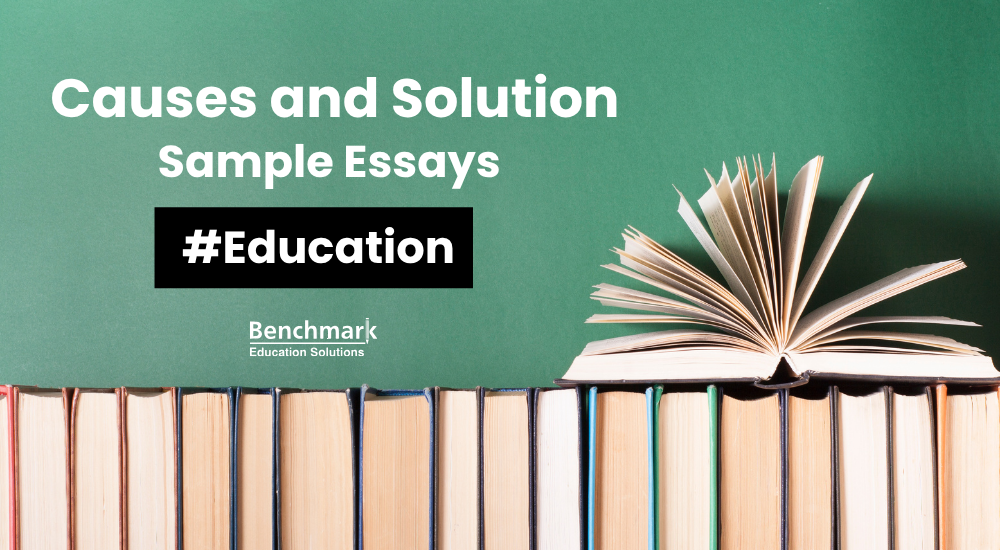IELTS Causes and Solution Essay: Education Topics with Sample Answers
- 0 Comments


In the Academic IELTS Writing section, education-related essay topics often focus on various aspects of the learning process and educational systems. Common subtopics might include: the role of technology in education, the impact of online learning, the value of vocational training, the debate between private and public schooling, and the influence of global education trends on local systems.Find useful IELTS vocabulary on education here.
Use Benchmark IELTS Writing Correction service to write error-free IELTS Essays, Letters & Reports.
Essay Topics
Task
Art is considered an essential part of all cultures throughout the world. However, these days fewer and fewer people appreciate art and turn their focus to science, technology and business. Why do you think that is? What could be done to encourage more people to take interest in the arts?
How to approach the essay:
This question asks you to identify the reasons why fewer people appreciate art today and suggest ways to increase public interest in it.
| Causes of Declining Art Appreciation | Proposed Strategies to Rekindle Interest |
|---|---|
| • Society prioritizes productivity and cost- efficiency over creative pursuits • Art is valued for revenue, not enjoyment or meaning • People focus more on science and technology than cultural enrichment | • Integrate art education into school curricula to reshape perceptions early • Organize public exhibitions, festivals, and workshops to increase accessibility • Highlight practical benefits of art (e.g., stress relief, emotional expression, creativity) |
Make sure your introduction paraphrases the topic and outlines both tasks, and your conclusion briefly summarizes the main ideas while offering a final thought.
Model Answer
In contemporary society, the appreciation of art is diminishing as individuals increasingly prioritize efficiency within a capitalist framework. This trend can be attributed to several factors, and there are practical strategies to rekindle public interest in the arts.
Cultivating an appreciation for art necessitates time and effort, as it involves understanding historical contexts and visiting museums to experience original works. However, in today’s fast-paced world, individuals are often preoccupied with maximizing productivity and minimizing costs, both at work and in their personal lives. As a result, few individuals dedicate time to engage with art and are fixated on science and technology. In such a context, the value of art is often measured by its potential to generate revenue through exhibitions, leading to a perception of art not as a source of enjoyment but rather as a means of generating income.
To foster greater public interest in the arts, several practical steps can be taken. Firstly, educational institutions should incorporate more art-related subjects into their curricula, allowing students to explore creative fields alongside academic ones. This early exposure can help shift the perception that art is less valuable than science or business. Secondly, governments and cultural organizations should sponsor public art exhibitions, community festivals, and free workshops to make art more accessible to people of all backgrounds. For example, showcasing local artists in public spaces or running school competitions in painting or music can encourage wider participation. Lastly, promoting the real-world benefits of art—such as stress relief, emotional expression, and creative problem-solving—can help people view it as both personally and professionally enriching.
In conclusion, the waning interest in art can be attributed to a contemporary society that prioritizes efficiency and productivity. However, by successfully promoting the advantages of art in enhancing human capabilities, it is possible to restore its prominence and encourage a renewed appreciation among the public.
Commentary
Essay Question: Art is considered an essential part of all cultures throughout the world. However, these days fewer and fewer people appreciate art and turn their focus to science, technology, and business. Why do you think that is? What could be done to encourage more people to take interest in the arts?
Introduction
• Clarity: Yes – The topic is introduced clearly with relevant background context.
• Thesis: Yes – Writer identifies the cause and outlines the intention to offer solutions.
Body Paragraphs
Main Ideas:
• Lack of time and focus on productivity limit engagement with art.
• Art is viewed more as a commercial tool than for enjoyment.
• Solutions: include art in education; sponsor public events; promote practical benefits of art.
Coherence:
• Well-organized with a clear cause-effect structure.
• Paragraphs transition smoothly from problem to solution.
• Solutions are directly relevant and well-explained.
Conclusion
• Summary: Effectively restates the main cause and solution.
• Opinion: Concludes with a forward-looking opinion about reviving interest in art.
Vocabulary & Grammar
High-Level Vocabulary:
• Cultivating: developing or fostering (used to discuss appreciation of art).
• Preoccupied: deeply absorbed in thought or focus (describing modern distractions).
• Fixated: overly focused (used in contrast to engagement with art).
• Perception: way of understanding or interpreting something.
• Prominence: state of being important or well-known.
Academic Phrases:
• “To foster greater public interest…”
• “This early exposure can help shift the perception…”
• “Several practical steps can be taken…”
Complex Sentences:
• “Although the younger demographic may initially resist this initiative, perceiving it as antiquated, engaging them through evocative media campaigns could significantly alter their perceptions.”
• “By successfully promoting the advantages of art in enhancing human capabilities, it is possible to restore its prominence…”
TaskIn schools and universities, girls tend to choose arts while boys like science. What are the reasons for this trend and do you think this tendency should be changed?
How to approach the essay:
How to approach the essay:
- Introduction:
- Rephrase the question/topic in your own words.
- Clearly state your opinion (agree/disagree) about the trend.
| Causes of Gender-Based Academic Preferences | Reasons to Maintain the Trend |
|---|---|
| • Boys tend to have stronger logical skills; girls excel in emotional expression • Parental influence encourages boys toward sciences and girls toward the arts | • Helps develop distinct social roles based on natural strengths • Aligning gender-based traits with careers fosters professional success (e.g., male engineers, female designers) |
- Conclusion:
- Summarize the main points.
- Restate your opinion clearly and concisely.
Model Answer
In educational institutions, a clear trend emerges where boys gravitate towards the sciences while girls tend to favor the arts. This pattern is influenced by both innate tendencies and parental guidance. I believe this trend should be maintained, as it offers distinct benefits related to individual strengths and societal roles.
Several reasons explain why male students predominantly pursue scientific disciplines, whereas female students are more attracted to the arts. Firstly, there are notable differences in the natural inclinations of the two genders. Boys often display stronger logical reasoning skills, while girls typically excel in emotional expression. For instance, boys enjoy constructing robots, whereas girls are more inclined to use colored pencils for artistic pursuits. Secondly, parental influence plays a crucial role in shaping the academic preferences of their children. It is commonplace for parents to encourage their sons to excel in subjects such as mathematics, physics, or the sciences, while daughters are often steered towards extracurricular activities like painting or dance.
I believe this tendency should remain unchanged because of the advantages it brings. A primary benefit is the development of distinct social roles for men and women. This stems from the observation that males often exhibit traits such as consistency and patience, which are invaluable in scientific careers. Females meanwhile appear to be more suited for professions related to the arts. Matching gender-based strengths with career paths can play a key role in helping individuals grow professionally. For instance, the success of male engineers in complex technological fields and female designers in creative industries illustrates how aligning natural strengths with career choices can lead to excellence.
In conclusion, the divergence in academic choices between boys and girls stems from their intrinsic traits and parental influence, and it is preferable to allow this trend to continue its natural course.
Commentary
Essay Question:
Why do boys often choose science subjects while girls prefer arts subjects? Should this tendency be changed?
Introduction
Clarity:
• Yes, the topic is introduced clearly with a relevant general statement.
Thesis:
• Clearly states the writer’s stance: supports the trend and gives a reason.
Body Paragraphs
Main Ideas (Pros/Cons):
• Innate tendencies: Boys → logic/reasoning; Girls → emotion/creativity.
• Parental influence: Sons encouraged in science; daughters in arts.
• Social roles benefit: Gender traits align with career expectations.
• Professional success: Career alignment improves outcomes (e.g., male engineers, female designers).
Coherence:
• Balanced in structure, but one-sided in opinion (no counter-arguments).
• Logical flow with smooth transitions between points.
Conclusion
Summary:
• Effectively restates main reasons and reinforces the author’s position.
• Reflects a clear and consistent stance.
Vocabulary & Grammar
High-Level Vocabulary:
• Gravitate towards – naturally move or be drawn to
• Innate tendencies – inborn or natural preferences
• Extracurricular – outside the normal curriculum
• Invaluable – extremely useful
• Divergence – difference or separation
Academic Phrases:
• “Several reasons explain why…”
• “Firstly, there are notable differences in…”
• “I believe this tendency should remain unchanged because of the advantages it brings….”
Complex Sentences:
• “This stems from the observation that males often exhibit traits such as consistency and patience, which are invaluable in scientific careers…”
• “For instance, the success of male engineers in complex technological fields and female designers in creative industries illustrates how aligning natural strengths with career choices can lead to excellence.”
More Articles
IELTS Causes and Effects Essay: Environment Topics with Sample Answers
In the Academic IELTS Writing section, environment-related essay topics often focus on global environmental issues and sustainable solutions. Common subtopics
IELTS Causes and Effects Essay: Crime and Security Topics with Sample Answers
Crime and security are common themes in IELTS Academic Writing Task 2, often focusing on how societies address criminal behavior
IELTS Advantage and Disadvantage Essay Topics: Technology Sample Answers
Master IELTS Writing Task 2 with sample advantage and disadvantage essays on technology-related topics like e-books vs paper books and online shopping. Improve structure, vocabulary, and coherence.
IELTS Advantage and Disadvantage Essay: Environment Topics with Sample Answers
Practice IELTS Writing Task 2 with sample advantage and disadvantage essays on environmental topics such as climate change, renewable energy, and plastic use. Balanced structure and model vocabulary included.








